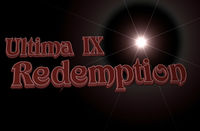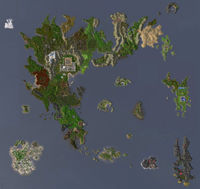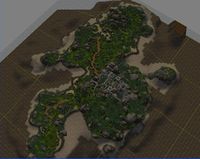Ultima IX: Redemption
Ultima IX: Redemption is a defunct project first initiated by a group of volunteer Ultima fans in 2001, then inherited in 2004 by a new team collectively known as the Titans of Ether. Conceived in response to players disappointed with Ultima IX, it aimed to provide an alternate climax to the Age of Armageddon saga within a customized version of Bethesda Softworks’ Morrowind engine. As such, the game was to feature a largely original plot set immediately after the events of Ultima VIII and intended to continue in a future sequel, Ultima X: The New King. After fifteen years of troubled development, however, Redemption was cancelled in December 2016.
Plot[edit]
Ultima IX: Redemption was to have taken place in Britannia in the year 380, seventeen years after the Avatar’s departure for Serpent Isle in Ultima VII Part Two. Having defeated the four Elemental Titans and escaped from Pagan in Ultima VIII, the hero would have returned as the Titan of Ether to find a realm in servitude to the Guardian and his invading legions, the Atarkans, who had executed a brutal conquest five years prior. Britannia's supplanted king, Lord British, was to have suffered imprisonment while the Atarkans enacted the Guardian's regime of inequity and deculturation, suppressing resistance by inquisition and enforcing their own edicts.
In Redemption, the returned Avatar would have been faced with the formidable task of not only subverting this occupation, but of finally bringing the Guardian's long campaign against Britannia to an end.
Setting[edit]
Whereas Britannia in Ascension underwent vast alterations to its geography, Redemption aimed to feature a comparatively traditional depiction of the world modeled on its earlier appearances, albeit with some settlements scarred from war and certain landmarks (Yew, Empath Abbey, Spiritwood) relocated. Islands seen in Ultima VII, such as the Isle of Fire, the western Valorian Isles, and Ambrosia, were to remain, while Bordermarch and Windemere were set to return from their disappearance prior to Ultima VI. New areas above and below ground were also to appear.
Development[edit]
Ultima IX: Redemption was in production from mid-2001 to early 2016 and, similar to its official counterpart, endured sweeping changes to its personnel and design.
Beginnings (2001–2004)[edit]
Redemption was originally conceptualized and co-directed by Scott "Avatus" Nicholas and Steven "Chlorthos" McCrary, two former members of "Moa Dragon"Alter U9 project (later Eriadain) who departed after growing dissatisfied with its creative and technical direction. Like contemporaneous fan projects Ultima V: Lazarus and The Ultima 6 Project, this first version of Redemption was intended to use Gas Powered Games’ Dungeon Siege toolkit. Its proposed storyline drew upon elements of team writer Laura "Shadow of Light" Campbell's Ultima fan fiction, The Black Ankh, and was directly prefaced by events unfolding in Ultima Legacy (a private Ultima Online server set in Britannia fifteen years after Ultima VII), which was, at the time, administrated by Avatus. Design goals included a focus on traditional Ultima hallmarks, non-linear gameplay, extensive world exploration, and multiple story paths.[1]
In mid-2002, the capabilities of the Dungeon Siege engine were deemed insufficient to meet these objectives, and a shift to Bethesda Softworks’ similarly customizable The Elder Scrolls III: Morrowind was settled upon. After one year with Morrowind, the eighteen-person team was reported to be nearing release of a playable demo.[2]
However, a crippling setback occurred in late 2003, when Avatus abruptly wiped the project's FTP server without warning nor explanation, before disappearing from the Ultima community entirely. With a considerable amount of work lost, Chlorthos and another team member attempted to keep Redemption afloat thereafter to little success, and production stagnated for much of the following year.
Titans of Ether (2004–2016)[edit]
In late August 2004, Chlorthos was contacted by Florian "Corv" Kasper, project leader of another fan game in development, Ultima: The New King. The two reached an agreement whereby the remaining Redemption personnel would be incorporated into Corv's team, jointly forming the "Titans of Ether". The Titans resolved to prioritize work on Redemption, with Ultima X: The New King planned as a direct sequel. However, it eventuated that a majority of the former Redemption team either resigned or fell out of contact under this arrangement, with the exceptions of Chlorthos and a relatively recent addition, writer Auriel "Direhaggis" Willette.
Additionally, the master file, storyline, and other data remaining from the former iteration of Redemption were retired, excepting recent work on character dialogue and certain aspects of the original premise (which, although never made public, remains archived). The Titans of Ether moved forward with a predominantly new foundation and plot treatment, while also expanding available gameplay options (e.g. mini-games reminiscent of the Final Fantasy series, intra-party conversations, multiple methods of solving quests, crafting, etc.).
Development was subsequently able to continue uninterrupted for several years, and by July 2010 exterior world-building had reportedly been completed, with the core narrative also said to be nearing full implementation. Assets pending at this time included interiors, side quests, and minor characters for some remaining areas.
OpenMW[edit]
In 2012, the Titans of Ether encountered major obstacles involving Redemption’s party system within the confines of the Morrowind construction set, which they hoped to overcome by moving to develop instead with OpenMW (an open source reimplementation of Bethesda's aging title). Production was postponed until this more flexible engine was judged to be in a usable state. However, in April 2013, the team instead announced they would circumvent the issue by removing the party system altogether, thus enabling them to continue without OpenMW.
A period of silence ensued until the following October, when Redemption was declared to be on indefinite hiatus as a result of persistent technical issues compounded by team instability. Activity resumed within months of this announcement, with the launch of a redesigned website and recommitment to OpenMW.
Two preview videos were released in 2015, the first showcasing various locations around Britannia, and the second a demonstration of the game's crafting system.
Cancellation[edit]
In December 2016, it was announced on the Titans of Ether website that Ultima IX: Redemption was officially cancelled, with the team having restarted earlier in the year on an original, Ultima-inspired role-playing game titled Corven: Path of Redemption.[3]
See also[edit]
References[edit]
- ↑ Nicholas, Scott. “U9 Redemption Frequently Asked Questions, V1.06”. U9 Redemption. 2002-02-01. Retrieved 2015-10-20.
- ↑ Nicholas, Scott. “Redemption Fact Sheet November 2003”. UltimaDot. 2003-11. Retrieved 2015-10-20.
- ↑ “Redemption is dead, long live Redemption!”. Titans of Ether. 2016-12-15. Retrieved 2016-12-19.




